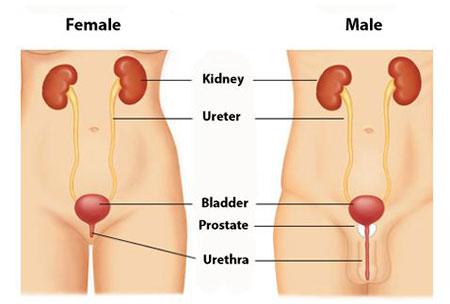Table of contents
WHAT IS A VOIDING CYSTO-URETHROGRAM?
A Voiding Cysto-Urethrogram (VCUG) is a minimally invasive test that uses a special X-ray technology called fluoroscopy to visualise your child’s urinary tract and bladder.
Urine is produced in the kidney and flows through the ureter, the tube that carries urine from each kidney to the bladder. A valve mechanism prevents urine from backing up into the kidneys as the bladder gets full. Urine leaves the bladder through the urethra and is eliminated from the body during urination.
A VCUG can help:
- Diagnose vesicoureteral reflux – a condition in which urine flows the wrong way, from the bladder back up to the kidneys;
- Determine why your child has recurring urinary tract infections;
- Discover if antibiotic treatment or anti-reflux surgery was effective;
- Check if there are any abnormalities or blockages of the urethra.

HOW SHOULD WE PREPARE?
You should inform your doctor of any medications your child is taking and if he or she has any allergies, especially to contrast materials. Also inform your doctor about recent illnesses or other medical conditions. An infection of the urinary tract must be excluded by a bacteriology test of the urine. If there is an infection, the VCUG will be postponed until the infection is cured.
Talk to your child about why the test is important and what it is designed to accomplish. Explain what will happen during the examination. Explain that you can stay with your child the entire time.
If you are pregnant, you will not be able to be in the room when X-rays are taken. Please bring another family member or friend instead.
Your child does not need to fast or wear special clothing.
HOW IS THE PROCEDURE PERFORMED?
This examination is usually done on an outpatient basis.
When you arrive in the Imaging Department:
- You will check in;
- You will be greeted by a staff member who will ask you some questions about your child’s condition explain the test and answer your questions;
- Your child will change into a hospital gown;
- If your child is toilet-trained, he or she will be asked to go to the bathroom before the exam;
- You and your child will be taken to the procedure room.
WHAT HAPPENS DURING THE TEST?
- The radiographer will help your child onto the fluoroscopy table.
- You will be allowed to stay in the room and be required to wear a lead apron to prevent radiation exposure.
- Your child will need to lie on his or her back. Our team is very aware of the sensitive nature of the area to be tested and makes every effort to ensure privacy and comfort.
- The radiographer will put on clean gloves and wash between your child’s legs with an antiseptic solution. It will be important for your child to remain still and to avoid touching his or her body below the waist. We realise laying still may be challenging for your child, we will give you suggestions on ways to distract your child in order to help them keep his or her body still.
- The radiologist will then proceed to the final disinfection and gently slide a very small tube (a catheter) coated with lubricating jelly into the small opening where urine comes out of the body (the urethra). The catheter can sometimes make children feel as though they need to urinate.
- The tube will be taped in place and a urine sample will be collected.
- A radio-opaque liquid will flow from a bottle through a tube, and into the catheter to fill your child’s bladder. This contrast material illuminates the urinary tract on X-ray images.
- Using fluoroscopy, a special x-ray technique, the radiologist will obtain images of your child’s bladder filling and emptying. The radiologist will check to see if any of the liquid contrast material goes backward into one or both ureters and kidneys and whether the shape and contour of the bladder and urethra are normal.
- If your child is old enough, we will ask him or her to urinate right on the table into a towel or a cup. This may be difficult, but it’s important. Babies will urinate on their own when the bladder is full.
A VCUG is painless, though young children can be anxious when they are tightly wrapped and unable to move. The antiseptic used to clean and prepare for the insertion of the catheter may feel cold. Some children may experience mild discomfort when the catheter is inserted and the bladder is filled with the liquid contrast material.
A VCUG is usually completed within 30 minutes.
WHAT HAPPENS AFTER THE VCUG?
The radiographer will let you know when your child may get dressed and you may leave. The radiologist will prepare a written report for your child’s doctor.
Your child may have some discomfort, pink urine, or feel a bit of stinging while going to the bathroom. This is normal and will go away. Drinking extra fluids will help.
Call your child’s doctor if your child has red blood in the urine, pain or a fever.
WHAT ARE THE LIMITATIONS OF VCUG?
VCUG cannot evaluate obstruction of flow of urine from the kidneys. Additional examinations are needed if such an obstruction is suspected.
VCUGmust not be performed if an untreated urinary tract infection is present.
For further information kindly contact our Imaging department at (028) 54 11 34 00



